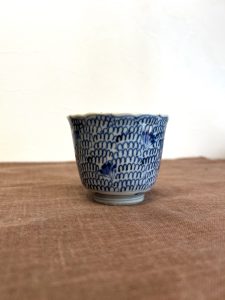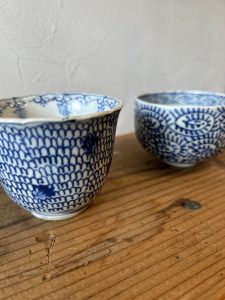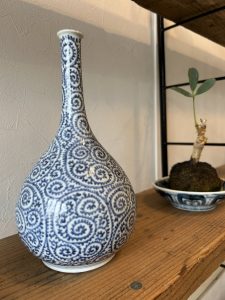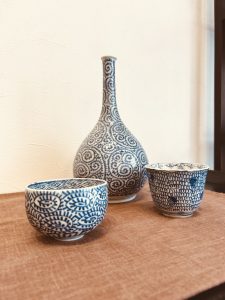唐草文様の概念が変わりました。(愛知県名古屋市千種区姫池通 骨董買取 古美術風光舎)
2023.10.14
皆さまこんにちは。スタッフHでございます。
食欲の秋、果物や秋野菜が美味しい季節となりました。子供の頃から種子系の食べ物が好物で、秋の楽しみと言えば銀杏です。東海地方の銀杏はぷっくり大きくて、初めて見た時は驚きました。
情報番組で知ったのですが、野生のイチョウの木は現在、中国の山奥に存在する2本のみで、他は全て人の手で植えられたものだとか。生き延びてくれて良かったです。
さて本日は、「唐草文様」について調べてみました。恥ずかしながら風呂敷の模様ぐらいしか思い浮かばない私でしたが、こちらの器のデザインが唐草模様だと聞いて興味を持ちました。(唐草文様とは、唐草という植物があるわけでなく、葉や茎やつるが伸びたり絡んだりした形を図案化した文様をいいます。)

文様の種類としては「微塵花(はな)唐草」と呼ばれ、陶磁器のみに描かれる唐草文様だそうです。唐草の小さな葉の部分が器全体に敷き詰められ、その中に小花が点々と散りばめられています。
陶磁器のみに描かれる唐草文様としては他に「蛸唐草文様」があります。つる草の茎や葉が絡み合ったように描かれ、渦上に巻いた蔓(つる)が蛸の足の吸盤を思わせることから、俗に蛸唐草と呼ばれています。蔓は生命力が強く途切れることなく伸びていくことから「繁栄・長寿」の意味があり、縁起のいい文様です。


蛸唐草文様や微塵花唐草は手描きの風合いが強く、温かみと味わいがあり眺めているとほっこりします。無謀にも自分でもちょっと描いてみたい衝動に駆られます。
唐草文様はテキスタイルや建造物の装飾模様として時代や文化を問わず広がり、進化を続け現在も人々に親しまれています。起源は古代エジプトのロータス(睡蓮)が始まりだといわれ、ロータスの帯状文様が古代ギリシャで優美な線を持ったパルメット唐草に発展し、壺絵などの装飾や建築装飾に頻繁に用いられるようになったとのこと。
ギリシャで唐草文様が誕生してから500~600年後にシルクロートを通って中国に伝来しました。唐時代になると華やかな時代を写し、牡丹唐草や宝相華(ほうそうげ)唐草が登場します。宝相華という架空の花と組み合わされた唐草文様で、とても華やかで優美な文様です。
中国から日本へは古墳時代の末期には伝播していたと考えられ、その後主に仏教美術の装飾文様として広まりました。日本名の「唐草文様」とは、「中国伝来の植物文様」、または「外国から来た文様」という意味だそうです。
高松塚古墳などからも出土している「海獣葡萄(ぶどう)鏡」の葡萄の文様が唐草になっています。葡萄は石榴(ザクロ)とならんで豊穣のシンボルとされ、中央アジア等で古くから聖なる果物として尊ばれたそうです。
日本では「唐草のみ」のものと「花と唐草が組み合わさったもの」があり、宝相華唐草として有名な平等院阿弥陀堂の鳳凰堂の装飾が有名だそうです。訪れたことがあるのですが、次回はじっくり拝見したいと思います。
唐草文様は着物や帯、茶道の仕覆や帛紗(ふくさ)、雛道具や大名道具にも多く見受けられ広く愛されていました。次第に図案化が進み、葉にあたる部分などは簡略化されていきました。それが私の知っている風呂敷の唐草文様なのですね。ヨーロッパにおけるユリやチューリップなどを用いたエレガントな雰囲気が強い唐草文様とは随分とイメージが異なっていったようです。
英語では唐草模様を「アラベスク」といい、意味は「アラビア風の装飾模様」で、他にもピアノの曲やバレエの演目としても知られています。音楽では装飾的で技巧的な音型をちりばめた幻想的な作品と位置付けられているそうです。
私の中で「唐草模様」の世界がかなり広がりました。ちなみにラーメン屋さんの角張った渦巻模様も唐草文様のひとつだそうです。これから至る所に唐草文様が見えてくることでしょう。楽しみです。

それでは、またお会いしましょう。
Hello everyone. This is Staff H.
Autumn is the season of appetite, and fruits and autumn vegetables are delicious. Ever since I was a child, I have been fond of seed-based foods, and one of my favorite autumn delicacies is ginkgo nuts. Ginkgo trees in the Tokai region are plump and big, and I was surprised when I saw them for the first time.
I learned from an information program that there are currently only two wild ginkgo trees existing deep in the mountains of China, and all the others were planted by human hands. I am glad they survived.
Now today, I looked up “arabesque patterns. I am ashamed to admit that the only pattern that came to mind was that of furoshiki (wrapping cloth), but I was surprised to hear that this vessel’s design was an arabesque pattern. (An arabesque pattern does not mean that there is a plant called “arabesque,” but rather a pattern that is designed with leaves, stems, and vines growing and twining around each other.)
The type of arabesque pattern is called “fine flower arabesque,” and is said to be an arabesque pattern that is depicted only on ceramics. The small leaves of the arabesque are spread over the entire vessel, and small flowers are scattered among them.
Another arabesque pattern depicted only on ceramics is the “octopus arabesque pattern. It is commonly called “octopus arabesque” because the intertwining stems and leaves of the vine are depicted, and the whorled vines remind one of the suckers on the legs of an octopus. The vine’s strong vitality and uninterrupted growth give it the meaning of “prosperity and longevity,” making it an auspicious design.
The octopus arabesque pattern and the flower arabesque pattern have a strong hand-painted texture, which gives them a warmth and flavor that makes you feel relaxed when you look at them. I am tempted to write some of these patterns myself.
The arabesque pattern has spread throughout time and cultures as a decorative pattern for textiles and buildings, and it continues to evolve and become popular even today. The origin of the arabesque pattern is said to be the lotus (water lilies) of ancient Egypt. The lotus band pattern developed into the Palmetto arabesque with graceful lines in ancient Greece, and it was frequently used for decorations such as vase painting and architectural decorations.
Five to six hundred years after the arabesque pattern was born in Greece, it was introduced to China via the Silk Route. In the Tang dynasty, peony arabesques and hosoge arabesques appeared, copying the glamorous era. These arabesque patterns combined with the imaginary flower called hosoge are very gorgeous and graceful.
It is thought to have spread from China to Japan by the end of the Kofun period, and later spread mainly as a decorative pattern in Buddhist art. The Japanese name “arabesque pattern” means “plant pattern from China” or “pattern from abroad.
The arabesque pattern on the “Grape and Sea Beast Mirror,” which has been excavated from the Takamatsuzuka burial mound and other sites, is based on the grape design. Grapes, along with pomegranates, are considered a symbol of fertility and have long been revered as a sacred fruit in Central Asia and elsewhere.
In Japan, there are two types of arabesques: arabesque only and arabesque combined with flowers. I have visited there and would like to take a closer look next time.
In English, the arabesque pattern is called “arabesque,” meaning “Arabian-style decorative pattern,” and is also known as a piano piece and ballet performance. In music, it is said that it is positioned as a fantastical piece with decorative and technical sound patterns.
The world of “Arabesque Pattern” has expanded considerably in my mind. Incidentally, the angular spiral pattern of ramen shops is also said to be one of the arabesque patterns. I am sure we will see arabesque patterns everywhere from now on. I am looking forward to it.
See you again soon.
*******************
ご実家の整理やお片付けなどをされている方のご相談などが多くございます。
お片付けなどくれぐれもご無理のないようになさってくださいませ。
風光舎では古美術品や骨董品の他にも絵画や宝石、趣味のお品など様々なジャンルのものを買受しております。
お片付けをされていて、こういうものでもいいのかしらと迷われているものでも、どうぞお気軽にご相談下さいませ。
また風光舎は、出張買取も強化しております。ご近所はもちろん、愛知県内、岐阜県、三重県その他の県へも出張いたします。
まずは、お電話お待ちしております。
愛知県名古屋市千種区姫池通
骨董 買取【古美術 風光舎 名古屋店】
TEL052(734)8444
10:00-17:00 OPEN
#出張買取#骨董#古美術#骨董品#絵画#版画#茶道具#刀剣#彫刻

